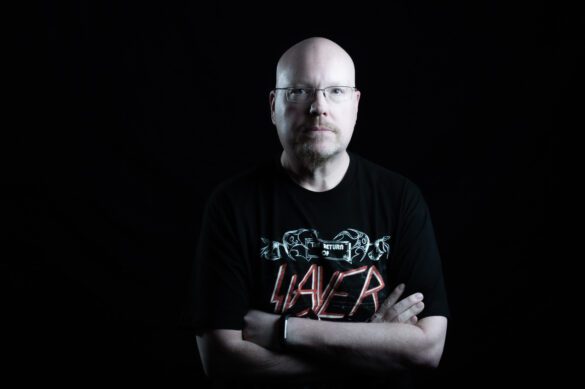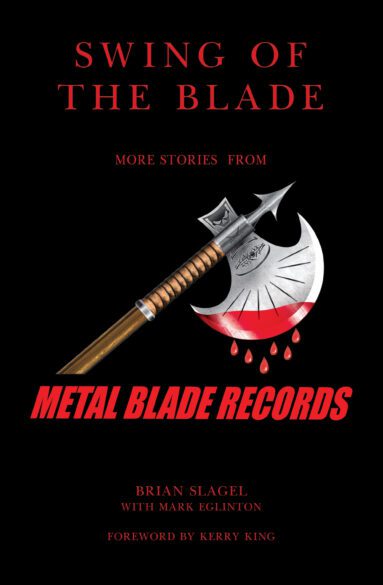
Photo by Gene Ambo

It goes without saying that Metal Blade Records founder Brian Slagel’s influence on the metal scene has been profound since he launched the label in the early ’80s, with the first Metal Massacre compilation. He and his label are responsible for bringing some of the greatest metal bands up and out of the underground, starting with Metallica and Slayer (among many other early MB-related acts) and continuing on today with a roster that includes Midnight, Cattle Decapitation, Revocation, Amon Amarth, Cult of Luna, Goatwhore and many, many others.
Not surprisingly, after 40-plus years immersed in metal, Slagel has some pretty incredible stories to tell about the bands he’s worked with. His first tome, 2017’s critically acclaimed For the Sake of Heaviness, set the table, offering his “origin story” as a burgeoning label owner. Now he’s dishing up even more behind-the-scenes tales in his upcoming book, Swing of the Blade: More Stories from Metal Blade Records, which is set for release on May 9 (and you can preorder here).

Decibel is honored to offer four exclusive excerpts from the book, one each week, through April, leading up to the book’s release. This week, we present a portion of the chapter “Band of Brothers: March of the (Armored) Saint.”
“Band of Brothers: March of the (Armored) Saint”
Armored Saint was just a bunch of young kids making their first full-length record for a major label. The last thing they were going to do was tell a high-profile producer [Michael James Jackson, KISS] what it should sound like. I’m sure they’d have just said, “Whatever . . . ” and so [March of the Saint] came out the way it came out. In the years since I’ve always wanted to go back and remix it.
In such a situation, there’s only one thing a band can do: accept their record for what it is and go out and get behind it on tour. And that’s exactly what Armored Saint did, on a tour with Metallica and W.A.S.P where Metallica—who wouldn’t become the band we know now until the Ozzy tour in ’86—headlined, with the exception of the L.A show, where Armored Saint topped the bill.
The second record, Delirious Nomad, produced by Max Norman and released in 1985, had a weird cover, a weird title and some frankly weird material. From what I understand, the record company was pressurizing the band into writing a hit song—which of course, never happened. Around that same time, guitarist Phil Sandoval left the band. I’m not sure why, but I suspect he might have been having some personal issues. The band continued as a four piece in the meantime.
Then on the third record, Raising Fear, it felt like the label was still looking for “hits,” because the album was divided into one half of really commercial-sounding stuff and another half of super-heavy material, including one of my all favorite songs of the band’s entire catalogue, “Book Of Blood.”
Shortly after Raising Fear, Chrysalis dropped the band. It just hadn’t worked out. Obviously, I was happy to have the band back on Metal Blade, and in 1988 we released a live album, Saints Will Conquer, by which time the band had replaced Phil Sandoval with Jeff Duncan, who we all knew from a band on the L.A scene called Odin. I don’t mind saying that I never really liked Odin. They sat somewhere in the middle of the commercial side of things and the heavier stuff. I just wasn’t a fan. And when the band said they were getting Jeff, I remember saying, “You’re getting him? Really?”
As it turned out, Jeff was a great guitar player who fit right in with Armored Saint. The first gig I saw with him I remember thinking: “Oh wow. This guy’s really good!”
Around this uneasy time, it was discovered that guitarist Dave Prichard was suffering from leukemia. Now, I don’t think anyone would be offended if I said that Dave was the heart and soul of the band and the creative driving force responsible for coming up with most of the riffs. On top of that he was a phenomenal, friendly and super-smart guy.
Back in 1988, there were far less treatments available for this disease that Dave had. A bone marrow transplant appeared to be one of the only things that could fix it. And from what I understand, to have an exact match was key to successful treatment. However, Dave was adopted; he never knew his biological parents. He didn’t have a family member from whom to get an exact bone marrow match so they had to find a donor with as close a match as they could, which they did, but it wasn’t enough. Dave eventually passed away. His loss hit everyone so hard.
At this point, feeling the combined pain of getting dropped after three records and losing their talisman Dave, I think the band felt absolutely defeated. They were done. They had no idea what to do. I remember talking to John [Bush] and Joey [Vera] and they said that they didn’t even know if they were going to try and keep the band going.
But in preparation for making what they thought would be their next album on Chrysalis, they had all these amazing demos that they’d done with Dave before he passed away. After a respectful while of letting them grieve, I went to the band to talk to them.
“I understand that it’s a tough situation and that I know you guys are burned out. But we can’t let these demos go to waste,” I told them.
The sad truth is that what they had gone through with a major label wasn’t exactly unusual at that time. I can think of a few bands that would have been pretty disillusioned and hurt by their experiences in the 1980s. But I also knew that the demos they had were some of the best music that Armored Saint and Dave Prichard had ever written, and I was hoping that I could encourage them to summon the will to get the band back on track by putting that music out.
Initially, they just weren’t sure. But after a while of me politely encouraging and badgering, they kind of came round to the idea of putting together what I believe is their best album, Symbol Of Salvation.
Of great help at that time was the fact that we’d just started our relationship with Warner Bros. Also, I was very much involved with marketing for Alice In Chains and so I knew the producer Dave Jerden, who’d produced Alice In Chains’ Dirt and Jane’s Addiction’s Ritual de lo Habitual, among many others.
I played Dave the demos and he really liked them. Simultaneously, QPrime, who’d managed Armored Saint from the beginning, came back on board with renewed support and enthusiasm. At that point, a number of great components had collided to create a situation whereby Armored Saint were perhaps better placed than they’d ever been with this great new material. Everyone was completely into making it a success.
The record—the making of which I discussed briefly in my first book—came out in 1991. And the only problem with that was that it was 1991, when heavy metal was supposedly in the process of dying—depending on whose opinion you listened to. While the critical response was overwhelmingly positive and as good a record as Symbol of Salvation clearly is, it was released at a horrible time when everyone just wanted to talk about Nirvana.
Consequently, as hard as everyone tried, we just couldn’t get the record over that invisible hump. The band toured, MTV played the videos and we got some radio play, but because the music just didn’t represent the flavor of that time, we couldn’t get the kind of impact that we wanted.
When you’re in the middle of it, you’re not really aware of these things. But looking back, I acknowledge that we released that record at absolutely the wrong time. If it had come out in 1988, it could well have been absolutely huge. As it stands, it’s still a phenomenal record. And as often as I’ve been asked in interviews over the years about what my favorite Metal Blade record is, I’ll always have difficulty naming any record other than Symbol of Salvation as top of that list. For me, to be involved in a record that rekindled the band’s fire, while at the same time preserving Dave Prichard’s legacy via those songs, will always be very special to me.
To read the rest of the “Band of Brothers” chapter, order Swing of the Blade here.

